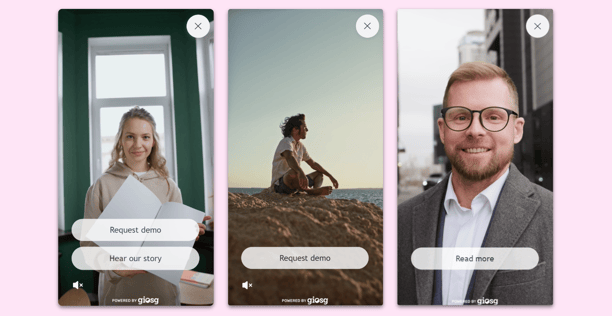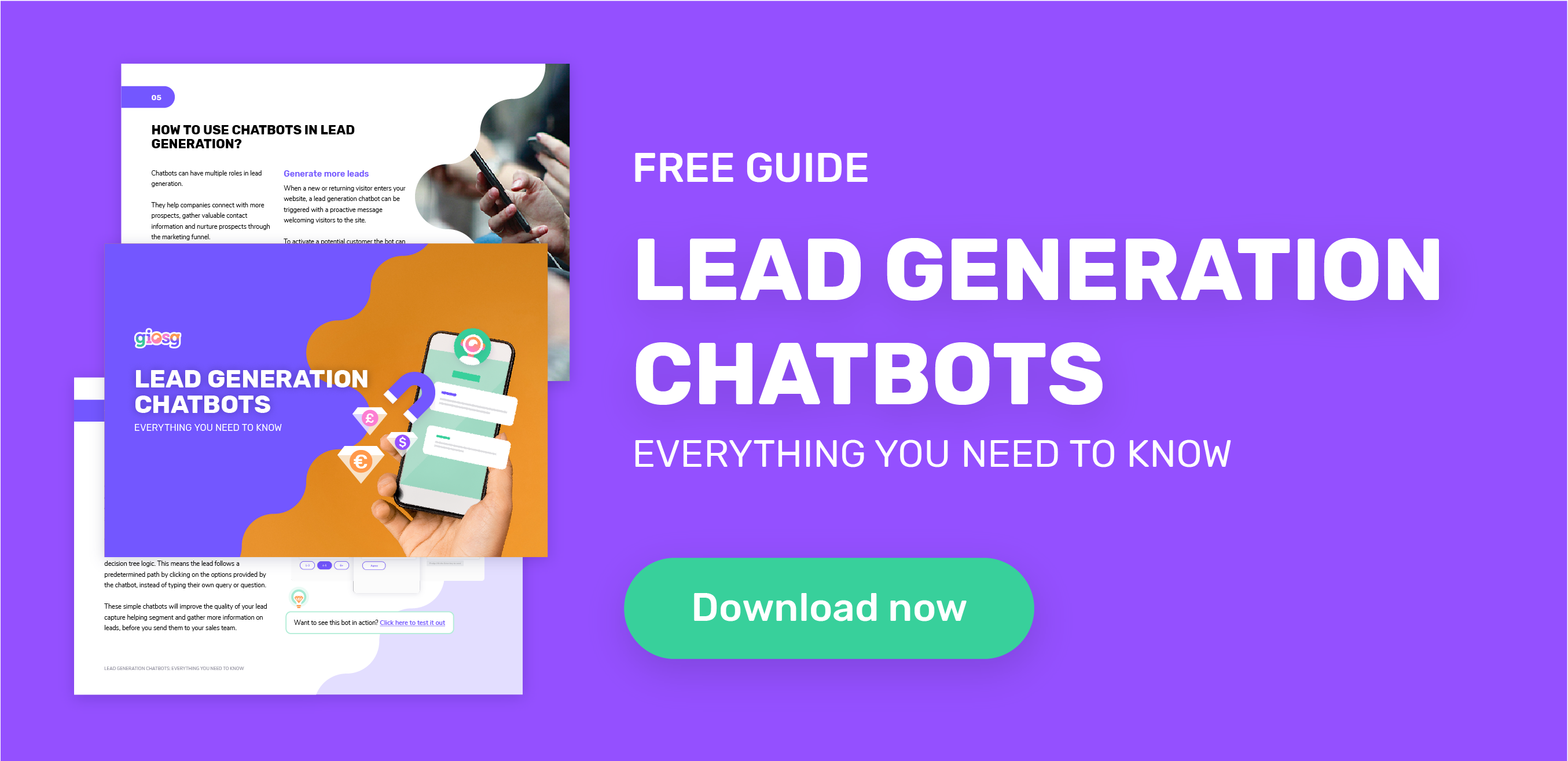Conversational marketing is all about communicating with your customers and prospects in a personalised way using real-time channels.
With their conversational approach and 24/7 availability, chatbots play an essential role in this.
By following the best practices for chatbot, you not only engage your website visitors but collect valuable information and qualify your leads further – this way you'll only send ready-to-buy leads directly to your team.
In this article, we share our proven chatbot best practices and top 7 tips for using them to reach and convert your target audience in an effective, delightful and personalised way:
1. Set clear goals and targets
2. Plan your chatbot flow
3. Keep it simple and user friendly
4. Greet and guide visitors
5. Use efficient targeting
6. Promote your offering in creative ways
7. Ask for feedback
1. Choose the right chatbot goals and target pages
Setting your chatbot up for success starts with establishing clear goals and selecting the pages where you want your conversations to take place.
For this, you should always begin by leveraging your website pages based on where you receive the most traffic, and have high-intent visitors.

These can be ones where your visitors are most likely to make a purchase, fill in a form, download your content etc. – it all depends on what you want to accomplish.
Remember! To build chatbots that convert, people need to see your chatbot in the first place.
So to optimise your results, place the chatbot on the pages that both get high levels of traffic and convert well on your chosen goal.
Don't forget to consider, what kind of chatbot should you use; ai chatbot or a rule-based bot. Or if on certain pages a live chat option would be more effective.
2. Plan a chatbot flow that works for you
Once you’ve found the ideal place for your chatbot, you can move to the next phase – planning your bot conversation flow.
This should be based on your chosen strategy and the stages of your website visitors' journey.
For example, the number of questions and the type of things you should ask will vary based to the customer journey.
At the top of your marketing funnel, you may only want to ask for the visitor’s email. Whereas further down the funnel you may want to collect more specific information.
Top tip! Make sure your chatbot doesn't end up being static and boring – this might put off people who are not yet familiar with your brand's products or services. The possibilities with your bot are endless.
You may want to consider engaging your visitors by including videos, games or product recommendations in your bot design. With the best chatbots out there, this should be simple to set up.
Best practice bonus tip: Automate with AI
One of the best practice tips for businesses looking to streamline operations and enhance customer experience is to automate with AI.
By implementing conversational AI and AI chatbots, you can offer 24/7 customer support, handle common queries, and personalize interactions with your customers.
Your AI chatbots can be programmed to understand and respond to natural language, making interactions with customers feel more human-like and efficient.
AI can also help automate a lot of repetitive tasks like data entry, scheduling, and administrative processes, freeing up valuable time for employees to focus on more strategic and creative tasks.
Don't forget that automation with AI can also lead to significant cost savings and improvements in productivity.
Use a chatbot to meet these customer needs, but also have your live chat option also displayed when your chatbot can't match the user's requirements. This is one of the key things in using automation and utilizing your chatbot the right way.
3. Give your chatbot a simple and user friendly tone
One of the main benefits of a successful chatbot is that it can improve the customer experience. So make sure you don't accidentally end up doing the opposite.
To provide a good visitor experience, try to keep your chatbots simple and consistent across the customer journey.
People expect to get prompt answers to their questions and find information without major efforts. Making it too complicated can lead to drop-offs and misunderstandings.
.png?width=2240&height=1260&name=Blog%20visuals%20(88).png)
This also includes keeping a consistent tone of voice with your bot. It should always follow your brand guidelines to deliver a consistent message.
But also to make sure the message resonates with your audience, choose terminology and words that they typically use.
Use casual, conversational language to make the communication feel more human. Or as mentioned before, you may want to considering adding your very own video on your bot.
People like a human touch in a chatbot although they know they are not having a conversation with a human. This will improve customer engagement and make your chatbot successful in a long run.
4. Greet and guide your target audience also outside business hours
Your bot can open immediately to welcome and greet a first-time visitor as they arrive on your website – whenever this may happen.
.png?width=612&height=344&name=Blog%20visuals%20(90).png)
And, once they’ve shared their contact information and become regular visitors, you can use your chatbot conversations to address them with a more personalised message based on the information you’ve gathered on their path while on your site.
In case your visitors get lost on your site and can’t find what they’re looking for, your chatbot is there to guide them to the right place.
One of the best ways to do this is with a simple button-based bot and predefined answers that smoothly lead your visitors through the website.
5. Use chatbots for efficient targeting
In the awareness stage of the customer journey, people are looking to educate themselves on your brand when they land on your site.
.png?width=2240&height=1260&name=Blog%20visuals%20(89).png)
But people who are further down the funnel will most likely want to know more information about your specific products or services.
All of these visitors will be pleasantly surprised if your chatbot offers them content on a topic they’re interested in. Never underestimate the power or a good user experience.
Whatever it is they're looking for, by having your chatbots taking care of the guidance and simple FAQs, you can focus on capturing new lead and handling more complex customer cases.
6. Promote your offering in creative ways
Some of your visitors may come to your website with a problem knowing that your company offers a solution.
That is a great opportunity to use a chatbot to find out what the problem is and to promote your products or services accordingly.
When prospects are interested in your products they want to have human-to-human contact with your company. In these cases you can let them book a demo or schedule a meeting with a human agent.
Top tip: Consider bringing your team directly to your website with videobots for more personalized touch!
Your bot can proactively offer this option when having a live or automated conversation, or even when the prospect is on product or pricing pages.

7. Ask for feedback and optimize your chatbot performance
And lastly, don’t forget to use your bot to ask for feedback from your customers and prospects whenever having a conversation with them.
One of the key best practices and to avoid making it feel forced, it’s better to leave it as an option and not make it a mandatory step.
Getting this feedback from your visitors can really help you improve things for the future and make them feel cared for! Again, a huge factor in making customer satisfaction happen.
Time to implement these chatbot best practices
Hope these best practices will help you get your foot in the door and on your way to build a chatbot that helps your business.
Whether it's for you're just taking the first steps in chatbot implementation or were looking for help for chatbot development – trust us, these tips should get you well ahead your competition.
If you’re interested in knowing more about using chatbots for converting leads and improving your customer experience, download our ultimate guide on Lead Generation Chatbots.

